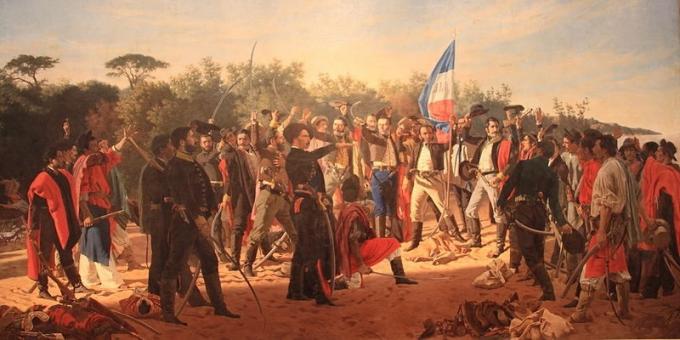What was racial segregation in the United States?
Racial segregation consists in the separation of people in the same public space of coexistence through laws whose criterion is the "breed", that is, an ideological conception of race often supported by dubious scientific theories and cultural prejudices. In the United States of America, which began to exist politically from its Independence, in 1776, racial segregation began to take effect at the beginning of the 19th century, when there was still slavery – a typical phenomenon in the states of the southern region of that country.
Civil War and End of Slavery
In the southern US slave states there were anti-miscegenation laws, that is, whites were prohibited by law from marrying blacks, even freedmen, or mestizos. The state of Indiana, in its Constitution of 1851, prohibited freed blacks and mestizos from taking up residence in its territory. When the Southern Confederate States lost the Civil warTo the Northern States, led by Abraham Lincoln, in 1865, segregation laws intensified, as the slavery – which supported the eminently rural economic model of the South – had been abolished two years earlier.
Southern whites did not want to share the same rights with freed blacks, nor did they want to allow blacks to rise to high political and legal positions. To dismantle the racist laws of the South, the Union, that is, the United States of the North, had to militarily occupy the southern states, in a process known as Restoration – which actually consisted of the reintegration of the South with the North.
Formation of the Ku Klux Klan and the Jim Crow Laws
In the final year of the Civil War (1865), the Ku Klux Klan in the state of Tennessee. The Klan (as it is also called) was a paramilitary group of fanatics who mixed racial ideology with religion and promoted aggressions, persecutions, murders and attacks on public establishments frequented by black people, such as restaurants and temples religious. The first members of the Klan were veterans of the Confederate forces, and its first leader was the general. Nathan Bedford Forrest. The Ku Klux Klan was repressed by the Restoration government, but would come back later, in the early 20th century.
In 1876, the military occupation of the southern states ended. Taking advantage of the federative condition of the USA, in which each state of the Federation was fully free to make their own laws, southerners passed a set of laws that became known like Jim Crow Laws. The content of these laws was completely segregationist and had as criteria what the geographer Demetrio Magnoli, in his book A Drop of Blood: History of Racial Thought, calls r"single drop of blood" picture. It was not necessary for a certain person to be visibly black to be discriminated against by segregationist laws. All it took was for it to be proven that this person had a black ancestor.
Virginia Law of 1924 and the phenomenon of passing racial
The “one drop of blood” criterion has been the basis for the legal system of discrimination for nearly 90 years. This rule was only actually repealed in the southern states of the US in the 1960s and 1970s. Before that, segregation was institutionalized in several states. The most emblematic case was that of Virginia State Act of 1924, that, in your item 5, it says:
It will be illegal from now on for any white person to marry anyone who is not a white person or to a person with a mixture of non-white and American Indian blood. For the purpose of this law, the term ''white person'' should be extended only to those who have no trace of any blood other than Caucasians; but people who are 1/16 or less of American Indian blood and have no other non-Caucasian blood should be defined as white people.
As seen, this law narrates the criteria for defining an individual's race. This criterion was adopted as the standard in virtually all segregationist states in the US, which further stimulated the racism in that country (In Brazil, unlike in the US, racism was never institutionalized, that is, made law).
As a way to "dribble" segregationism, many Americans of black descent, but of color white, sought to falsify their history by changing their name, building a new identity etc. This phenomenon became known as passing racial, as highlighted by Demetrius Magnoli in a book already cited:
“The bipolar racial model of the USA converts mestizos from unions between whites and blacks into blacks. Among the most notable effects is the phenomenon of passing, a strategy of identity reinvention by which an individual ''pretends'' as a member of a social group in which he or she would not normally be admitted. As a rule, in the American racial passing, a mestizo, socially classified as black, remakes his identity as white.” 1
The most notorious example of passing, according to Magnoli, is that of Walter Francis White, who was chief executive of NAACP (National Association for the Advancement of People of Color) between 1929 and 1955. White was "a mestizo with 27 white fourth-generation ancestors and five blacks, but defined as black by the one drop rule. Blond, blue-eyed and white-skinned, White passed for white during his investigations of lynchings committed in the south against blacks..” 2.
Civil rights movements and the desegregation process
The racial segregation laws in the USA only began to be repealed after the outbreak of movements by the civil rights and equality of law between blacks and whites led in the 1950s and 1960s by leaders like Martin Luther King Jr., which was notable for its ability to rally large masses of people in peaceful protests.
____________________________________
1MAGNOLI, Demetrius. A drop of blood – history of racial thought. São Paulo: Context, 2009.
2Idem.
* Image credits: Shutterstock and Everett Historical
By Me. Cláudio Fernandes
Take the opportunity to check out our video lesson related to the subject:


